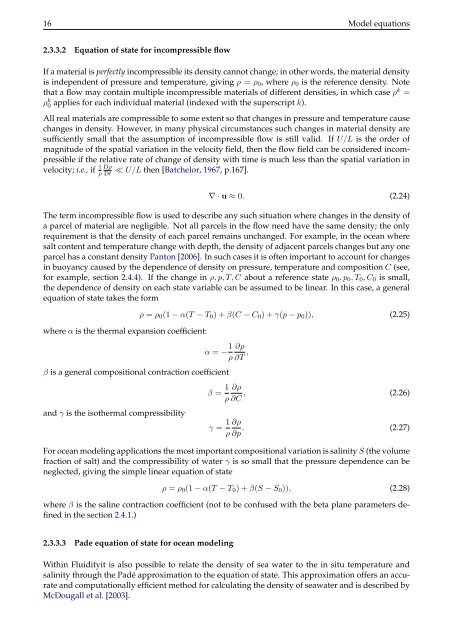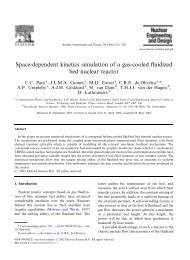Chapter 8 Configuring Fluidity - The Applied Modelling and ...
Chapter 8 Configuring Fluidity - The Applied Modelling and ...
Chapter 8 Configuring Fluidity - The Applied Modelling and ...
You also want an ePaper? Increase the reach of your titles
YUMPU automatically turns print PDFs into web optimized ePapers that Google loves.
16 Model equations<br />
2.3.3.2 Equation of state for incompressible flow<br />
If a material is perfectly incompressible its density cannot change; in other words, the material density<br />
is independent of pressure <strong>and</strong> temperature, giving ρ = ρ0, where ρ0 is the reference density. Note<br />
that a flow may contain multiple incompressible materials of different densities, in which case ρk =<br />
ρk 0 applies for each individual material (indexed with the superscript k).<br />
All real materials are compressible to some extent so that changes in pressure <strong>and</strong> temperature cause<br />
changes in density. However, in many physical circumstances such changes in material density are<br />
sufficiently small that the assumption of incompressible flow is still valid. If U/L is the order of<br />
magnitude of the spatial variation in the velocity field, then the flow field can be considered incompressible<br />
if the relative rate of change of density with time is much less than the spatial variation in<br />
velocity; i.e., if 1 Dρ<br />
ρ Dt ≪ U/L then [Batchelor, 1967, p.167].<br />
∇ · u ≈ 0. (2.24)<br />
<strong>The</strong> term incompressible flow is used to describe any such situation where changes in the density of<br />
a parcel of material are negligible. Not all parcels in the flow need have the same density; the only<br />
requirement is that the density of each parcel remains unchanged. For example, in the ocean where<br />
salt content <strong>and</strong> temperature change with depth, the density of adjacent parcels changes but any one<br />
parcel has a constant density Panton [2006]. In such cases it is often important to account for changes<br />
in buoyancy caused by the dependence of density on pressure, temperature <strong>and</strong> composition C (see,<br />
for example, section 2.4.4). If the change in ρ, p, T, C about a reference state ρ0, p0, T0, C0 is small,<br />
the dependence of density on each state variable can be assumed to be linear. In this case, a general<br />
equation of state takes the form<br />
where α is the thermal expansion coefficient:<br />
ρ = ρ0(1 − α(T − T0) + β(C − C0) + γ(p − p0)), (2.25)<br />
α = − 1 ∂ρ<br />
ρ ∂T ,<br />
β is a general compositional contraction coefficient<br />
<strong>and</strong> γ is the isothermal compressibility<br />
β = 1 ∂ρ<br />
, (2.26)<br />
ρ ∂C<br />
γ = 1 ∂ρ<br />
. (2.27)<br />
ρ ∂p<br />
For ocean modeling applications the most important compositional variation is salinity S (the volume<br />
fraction of salt) <strong>and</strong> the compressibility of water γ is so small that the pressure dependence can be<br />
neglected, giving the simple linear equation of state<br />
ρ = ρ0(1 − α(T − T0) + β(S − S0)), (2.28)<br />
where β is the saline contraction coefficient (not to be confused with the beta plane parameters defined<br />
in the section 2.4.1.)<br />
2.3.3.3 Pade equation of state for ocean modeling<br />
Within <strong>Fluidity</strong>it is also possible to relate the density of sea water to the in situ temperature <strong>and</strong><br />
salinity through the Padé approximation to the equation of state. This approximation offers an accurate<br />
<strong>and</strong> computationally efficient method for calculating the density of seawater <strong>and</strong> is described by<br />
McDougall et al. [2003].




